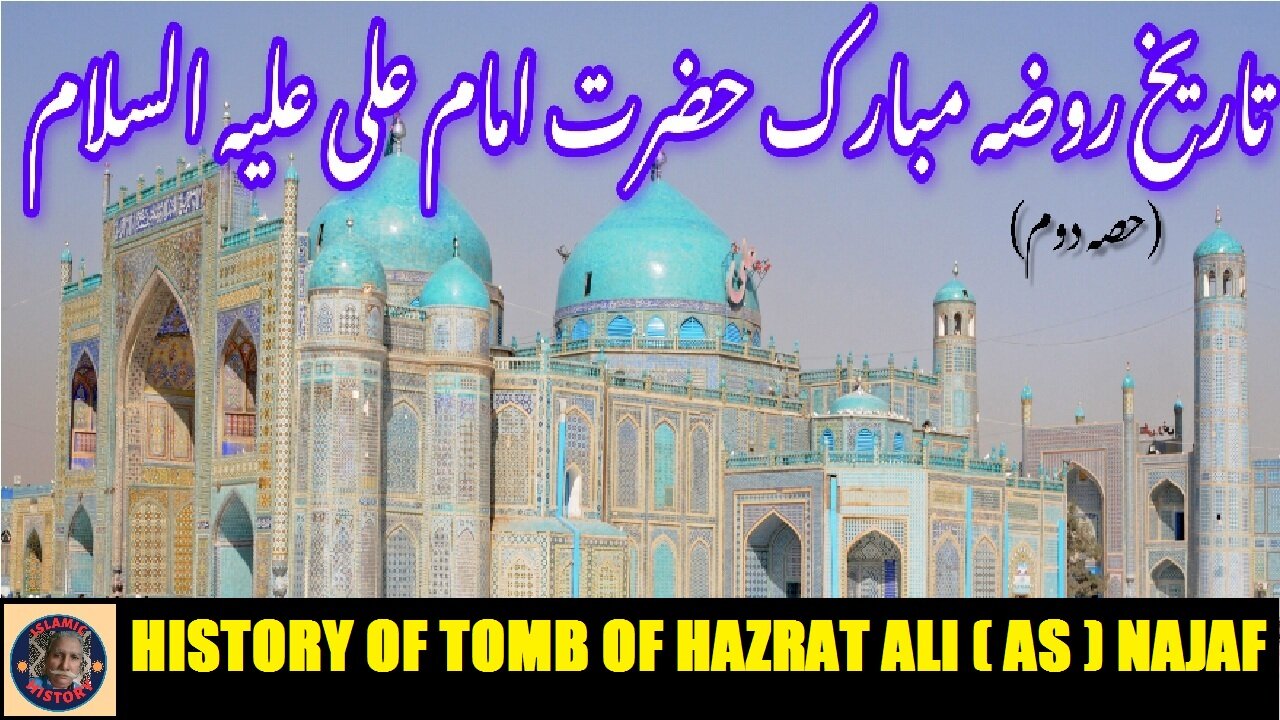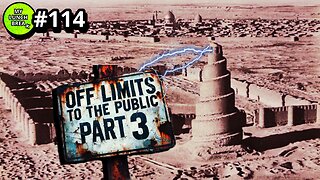Premium Only Content

Part-2 | The History of Shrine Hazrat Imam Ali (AS) روضہ مبارک حضرت امام علی علیہ السلام کی تاریخ
@islamichistory813 #IslamicPilgrimage #HazratAli #SacredSite
The History of Islamic Holiest site Shrine Hazrat Imam Ali (AS)
Part-2
Asslamoalaikum sisters brothers friends and elders, Today we are describing remaing history of most holiest place of Muslim Tomb of Hazrat Imam Ali (AS), Please be with us upto end of this video. as we are describing about holiest sites of Islam. Describing the historical background and religious importance of this sacred site, and learn about the revered figure of Hazrat Imam Ali (AS) in Islamic tradition.
The Mausoleum
“The Mausoleum itself of Hazrat Ali at Najaf, is breathtaking. There is one large central dome which stands out of a square-shaped ornate structure at the two sides of which are two minarets. The predominant color of' the exterior is gold, bright shining gold and the entire exterior of the mausoleum is inlaid with a mosaic pattern of light powder blue, white marble, gold again with an occasional splash of Middle East rust.”
So says D. F. Karaka after his visit to Najaf, and further adds, “I have sat and wondered at the marbled splendour of our Taj Mahal, the tomb which Shah Jahan built for his Empress Mumtaz Mahal, but despite its beauty, the Taj appears insipid in comparison with this splash of color at Najaf. The tomb surpassed anything I have seen in gorgeous splendour. All the great kings of the world put together could not have a tomb as magnificent as this, for this is the tribute which kings and peasants have built together to enshrine the mortal remains of the great Ali.”
Countless number of people from all over the world flock to his tomb day after day to pay their respects and to offer salutations and to pray to Allah seeking his intercession. And those who cannot afford to go there personally, are constantly praying to Allah to help them to visit the shrine of their Maula Ali, and when somebody goes on a pilgrimage to Najaf, they request him to offer salutations on their behalf, and to pray to God - for some particular favor - and to seek Imam Ali's intercession.
The deer hunting incident of Harun al-Rashid
“During the reigns of the Umayyad Caliphs his blessed resting-place could not be disclosed, and so it was also under the Abbasids until the reign of Harun al-Rashid. But in the year 175 A.H. (791 A.D.), Harun happened to go hunting in these parts, and the deer he was chasing took refuge on a small piece of raised ground. However much he asked his hunting dogs to capture the quarry, they refused to go near this spot.
He urged his horse to this place, and the horse too refused to budge; and on this, awe took possession of the Caliph's heart, and he immediately started to make inquiries of the people of the neighborhood, and they acquainted him with the fact that this was the grave of Imam Ali ibn Abu Talib, the cousin and son-in-law of the Holy Prophet. Harun ordered a tomb to be erected over the grave, and people soon began to settle down in its vicinity.”4
Discovering the Grave
In the era of Imam Ja'far al-Sadiq (a) when the Umayyads were being ousted from the caliphate, there was no longer a reason for the grave of Imam Ali (a) to remain hidden. Due to this, gradually, the location of his grave became known and exposed to everyone. It has been narrated that Safwan sought permission from Imam al-Sadiq (a) to tell the Shias of Kufa where the burial place of Imam Ali (a) was. The Imam (a) responded in the affirmative and also gave some money for the reparations and reconstruction of the grave.[4]
History of the Construction
With the deposal of the Umayyads, and the public discovery of the grave of Imam Ali (a), Dawud b. Ali al-Abbasi (d. 133/750-1) witnessed that many people were visiting the gravesite. As such, he installed a tombstone on top of the grave. However, after the establishment of the Abbasid caliphate, their relationship with the Alawis changed and the grave became abandoned once again and the tombstone was destroyed.[5]
Apparently, in approximately the 170/786-7[6], it was Harun al-Rashid who built the first shrine for Imam Ali (a) made from white bricks. He also gave orders for a building to be built on top of the grave from red clay, and for the green fabric to be laid across the shrine.[7]
In the same way that the Abbasid caliph, Mutawakkil (d. 247/861-2), destroyed the shrine of Imam al-Husayn (a), he also destroyed the shrine of Imam 'Ali (a) in Najaf.[8] After this, Muhammad b. Zayd al-Da'i (d. 287/900) rebuilt the grave, and furthermore, built a dome, walls, and fort for the shrine.[9]
Umar b. Yahya, renovated the shrine of Imam Ali (a) in 330/941-2 and he paid for the expenses to install a dome from his personal funds.[10]
'Adud al-Dawla al-Daylami (d. 372/982-3) renovated and constructed the building in such a way that it was completely unique in style for its era and he also set up endowments for it. This building remained until 753/1352-3. It was in this year that the building was burned down and destroyed. It has been said that in this fire, a manuscript of the Qur'an in three volumes written by Imam Ali (a) himself were also burned.[11] In addition to 'Adud al-Dawla, other Buyid rulers and their viziers, the Hamdanids, and some of the Abbasids (Mustansir al-Abbasi) also participated in the shrine's renovation and reconstruction.[12]
In the year 760/1358-9, a new building was constructed that has not been attributed to any particular individual. However, apparently, it was the work of Ilkhanates and many rules had a share in its building. Shah Abbas I restored the hall, dome, and courtyard of this building.[13]
Shah Safi expanded the courtyard of the shrine.[14]
In the travel diaries of Sultan Muhammad Mirza (who traveled in the year 1279/1862-3), it has been written that a fort was built by a person named Muhammad Husayn Sadr Isfahani. Furthermore, in his travel diaries, it is stated that a dome was first built during the Buyids and that it was dismantled during the Safavid era. He further notes that the dome that was into place that year (i.e. 1279/1862-3) was known to have been built by Shah Abbas I with Shaykh Bahai's designs.[15]
The golden detail of the dome, entrance, and both minarets was carried out by Nadir Shah Afshar.[16]
Architectural Features
Masjid Imran b. Shahin
This mosque has been named after Imran b. Shahin. It is one of the oldest mosques in Najaf and is located in the northern of the courtyard of Imam Ali's (a) shrine. It is currently considered to be a part of the shrine.[17]
When Imran rose up against the government of 'Adud al-Dawla, he was eventually defeated. After his defeat, he took an Nadhr that if 'Adud al-Dawla were to pardon him, he would build a portico (Rawaq) in the shrine of Imam 'Ali (a). When 'Adud al-Dawla pardoned him, he built this portico in the middle of the fourth/tenth century. Eventually, it became a mosque, and then became famously known as the Mosque of Imran b. Shahin. The mosque lay abandoned for some time until the dissolution of the Baathist government and the removal of Saddam Hussein from power. In more recent years, the mosque has been renovated in a grand fashion.[18]
A few prominent figures, like Sayyid Muhammad Kazim Yazdi (the author of 'Urwat al-Wuthqa), Sayyid Muhammad Kazim Muqaddas, and Muhammad Baqir Qummi have been buried in this mosque.[19]
Friends we will stop here and remaining history will be described tomorow same time into second part, Allah Hafiz
=========================
-
 27:57
27:57
MYLUNCHBREAK CHANNEL PAGE
14 hours agoOff Limits to the Public - Pt 3
61.9K49 -
 38:07
38:07
Michael Franzese
7 hours agoLeaving Organized Crime and Uncovering Mob in Politics: Tudor Dixon and Michael Franzese
49.5K13 -
 2:42:54
2:42:54
Jewels Jones Live ®
2 days agoAMERICA IS BACK | A Political Rendezvous - Ep. 111
46.2K41 -
 8:47:33
8:47:33
Due Dissidence
1 day agoLIVE: Workers Strike Back Conference ft. Chris Hedges, Jill Stein, Kshama Sawant, and More!
88.1K53 -
 8:36:37
8:36:37
Right Side Broadcasting Network
5 days agoLIVE REPLAY: CPAC 2025 Day Three with President Donald J. Trump - 2/22/25
407K94 -
 1:05:34
1:05:34
The Big Mig™
15 hours agoConfirmed Kash Patel New FBI Director, Bring On The Pain |EP483
88.9K24 -
 53:59
53:59
Tactical Advisor
11 hours agoThe Vault Room Podcast 009 | Everyone Getting $5000?!
72K11 -
 2:04:44
2:04:44
TheAlecLaceShow
22 hours agoLive at CPAC | Interviews with Dean Cain, Rep. Comer and more! | The Alec Lace Show
80.9K4 -
 LIVE
LIVE
Major League Fishing
3 days agoLIVE Tackle Warehouse Invitationals, Stop 1, Day 2
423 watching -
 3:12:37
3:12:37
I_Came_With_Fire_Podcast
18 hours agoNOC Spy: CIA uses SATANIC RITUAL ABUSE to make SLEEPER Cells
87.5K19